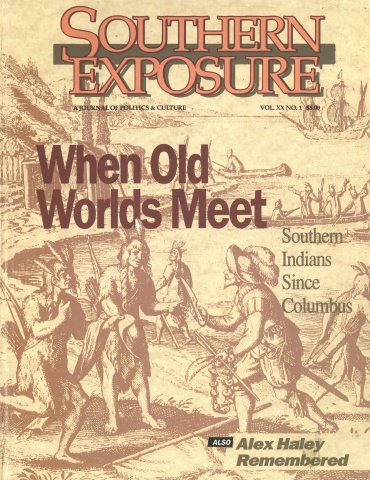Collard Greens

This article originally appeared in Southern Exposure Vol. 20 No. 1, "When Old Worlds Meet: Southern Indians Since Columbus." Find more from that issue here.
Perhaps more than any foods save com bread and barbecue, collard greens have come to symbolize the distinctive tastes of the South. The tough, broad leaves of the collard fed the region through slavery and civil war, and the inexpensive vegetable still serves as a staple on Southern farms and dinner plates.
A member of the cabbage family rich in vitamin A, the collard has nourished humans since the days of ancient Greece. The vegetable eventually wound its way across Europe and through England and Africa to the American colonies. Southern slaves cultivated collards to supplement their diets, and wealthy planters and poor whites alike survived on the hardy greens after Sherman decimated food supplies during the Civil War.
A cheap vegetable with a long growing season, the collard, along with cornpone and fatback, still serves as a standby for many poor rural families — especially during hard times. Even “pot likker,” a rich broth left over from boiling collards with salted pork, is considered a nutritious delicacy and aphrodisiac.
“Collard greens have always been my number-one item,” says James Shackleford, a farmer in Greene County, North Carolina. “We have collards when we can’t have anything else.”
According to Jimmy Green, executive director of the North Carolina Coalition of Farm and Rural Families, greens provide year-round crops and a steady source of income for small farmers. North Carolina, in fact, is home to more collard-growing farms than any other state, and the South harvests a whopping 70 percent of the nation’s 15,201 acres of collards.
Georgia tills the largest acreage of collards for sale, and six other Southern states rank among the top ten producers. The region also leads the nation in acreage devoted to other greens, farming 68 percent of all turnip greens, 53 percent of mustard greens, and 54 percent of kale.
Its economic and dietary importance has made the collard a true symbol of the South. Jazz great Thelonious Monk, a North Carolina native, sported a collard in his lapel when he played New York clubs, and North Carolina playwright Paul Green commemorated the leafy vegetable in a “Collards and Culture” symposium in 1950.
The mythic status of the collard is renewed each year at several local festivals. Gaston, South Carolina held its 10th-annual celebration of the vegetable last year, raising $4,000 for the town recreation center and museum. Jennifer Poole, co-chair of the event, says festival goers consumed over half a ton of collards—along with 2,000 squares of cornbread, 100 pounds of black-eyed peas, 3,000 yams, 500 pounds of ham, and 100 gallons of tea.
The town of Ayden on the North Carolina coast hosted its 17th-annual collard festival last year—a six-day affair that drew 15,000 people. The highlight was the yearly collard-eating contest; according to the rules, victory goes to whoever eats the most greens in 30 minutes and “then keeps them down long enough to receive the trophy and prize money.” The world record was set in 1984 by Mort Hurst, who swallowed 7.5 pounds of boiled greens.
The Ayden festival also inspired two professors at East Carolina University to publish Leaves of Green, a collection of 129 “collard poems.” Sixteen-year-old Kai-I Chung of Tarboro, North Carolina conveyed her distaste in a ballad entitled “Algae-Green Scum,” and M.L. Poole of Greensboro penned the shortest entry: “I think/They stink.”
But Cicely Browne of Raleigh eloquently captured the regional affection for the plant in her poem “Collard Rhyme”:
From age to age the South has hollered
The praises of the toothsome collard.
Our parents’ precepts we have follered,
And countless messes we have swallered.
When times were hard, a single dollar’d
Buy ample potfuls of the collard.
Full many a happy hog has wallered
In luscious leaves of wilted collard.
Yes, keep your cordon bleu —By Gollard!
I’d trade it all for one big collard!
Tags
Mary Lee Kerr
Mary Lee Kerr is a freelance writer and editor who lives in Chapel Hill, NC. (2000)
Mary Lee Kerr writes “Still the South” from Carrboro, North Carolina. (1999)